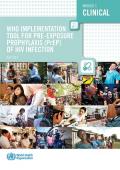Tools - Released in 2017
This PrEP tool contains modules for a range of stakeholders to support them in the consideration, planning, introduction and implementation of oral PrEP.
Following the WHO recommendation in September 2015 that “oral pre-exposure prophylaxis (PrEP) should be offered as an additional prevention choice for people at substantial risk of HIV infection as part of combination HIV prevention approaches”, partners in countries expressed the need for practical advice on how to consider the introduction of PrEP and start implementation.
In response, WHO has developed this series of modules to support the implementation of PrEP among a range of populations in different settings.
Summary of Modules
Module 1: Clinical. This module is for clinicians, including physicians, nurses and clinical officers. It gives an overview of how to provide PrEP safely and effectively, including: screening for substantial risk of HIV; performing appropriate testing before initiating someone on PrEP and while the person is taking PrEP; and how to follow up PrEP users and offer counselling on issues such as adherence.
Module 2: Community educators and advocates. For PrEP services to reach populations in an effective and acceptable way, community educators and advocates are needed to increase awareness about PrEP in their communities. This module provides up-to-date information on PrEP that should be considered in community-led activities that aim to increase knowledge about PrEP and generate demand and access.
Module 3: Counsellors. This module is for staff who counsel people as they consider PrEP or start taking PrEP and support them in addressing issues around coping with side-effects and adherence strategies. Those who counsel PrEP users may be lay, peer or professional counsellors and healthcare workers, including nurses, clinical officers and doctors.
Module 4: Leaders. This module aims to inform and update leaders and decision-makers about PrEP. It provides information on the benefits and limitations of PrEP so that they can consider how PrEP could be most effectively implemented in their own settings. It also contains a series of frequently asked questions about PrEP, with related answers.
Module 5: Monitoring and evaluation. This module is for people responsible for monitoring PrEP programmes at the national and site levels. It provides information on how to monitor PrEP for safety and effectiveness, suggesting core and additional indicators for site-level, national and global reporting.
Module 6: Pharmacists. This module is for pharmacists and people working in pharmacies under a pharmacist’s supervision. It provides information on the medicines used in PrEP, including the optimal storage conditions. It also gives suggestions for how pharmacists and pharmacy staff can monitor PrEP adherence and support PrEP users to take their medication regularly.
Module 7: Regulatory officials. This module is for national authorities in charge of authorizing the manufacturing, importation, marketing and/or control of antiretroviral medicines used for HIV prevention. It provides information on the safety and efficacy of PrEP medicines.
Module 8: Site planning. This module is for people involved in organizing PrEP services at specific sites. It outlines the steps to be taken in planning a PrEP service and gives suggestions for personnel, infrastructure and commodities that could be considered when implementing PrEP.
Module 9: Strategic planning. As WHO recommends offering PrEP to people at substantial HIV risk, this module offers public health guidance for policy-makers on how to prioritize services, in order to reach those who could benefit most from PrEP, and in which settings PrEP services could be most cost-effective.
Module 10: Testing providers. This module is for people who are responsible for providing testing services at PrEP sites and associated laboratories. It offers guidance in selecting relevant testing services, including appropriate screening of individuals before PrEP is initiated and monitoring while they are taking PrEP. Information is provided on testing for HIV, creatinine, hepatitis B and C virus, pregnancy and sexually transmitted infections.
Module 11: PrEP users. This module provides information for people who are interested in taking PrEP to reduce their risk of acquiring HIV and people who are already taking PrEP – to support them in their choice and use of PrEP. This module gives ideas for countries and organizations implementing PrEP to help them develop their own tools.
Module 12: This module is for people who are interested in providing PrEP services to older adolescents and young adults who are at substantial risk for HIV. It provides information on: factors that influence HIV susceptibility among young peopl;enical considerations for safety and continuation on PrEP; ways to improve access and service utilization; and inclusive monitoring approaches to improve the recording and reporting of data on young people.
Module 13: This module is intended to complement the other modules in the WHO PrEP implementation tool. It focuses on the integration of STI services for people who may benefit from or use PrEP. The module is divided into two parts: the first focuses on programme managers and other decision-makers, and the second on health care workers. People who use PrEP will also benefit from the module.
Downloads
Organizations
- World Health Organization (WHO)






